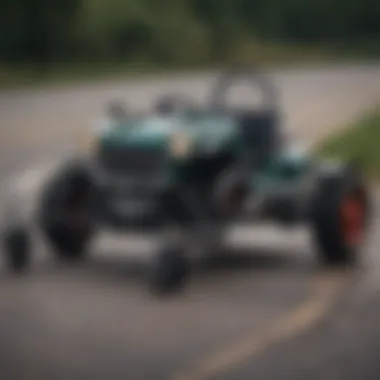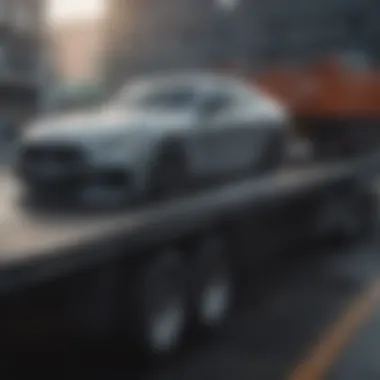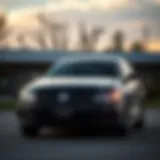Essential Guide to Towing a Non-Running Car


Intro
Towing a non-running car can feel like trying to herd cats. Whether your vehicle sputtered its last breath on the highway or decided to call it quits in your driveway, knowing how to tow it effectively is crucial. The whole process can be riddled with complexities if you don’t know what you’re doing. This guide equips you with the knowledge to tackle this challenge head-on, covering everything from assessing the vehicle’s state to selecting the right tools and techniques.
Understanding the Process
Towing isn’t just about finding a tow truck and hitching up the vehicle. It requires a careful evaluation of the car’s condition. You must take stock of the situation, ensuring you choose the most suitable method for towing. If you skip this step, you could find yourself in a sticky situation—possibly even damaging either vehicle involved.
It's not all doom and gloom, though. By mastering a few key principles, you'll navigate the nuances of towing with a level of confidence that might even surprise you. So, buckle up as we delve into this indispensable guide tailored for car enthusiasts and owners alike.
Prelims to Towing Non-Running Cars
Towing a non-running car isn’t just about throwing some ropes and pulling; it involves understanding several intricate factors and strategies. For car enthusiasts and everyday drivers alike, knowing how to tackle this task can save you both time and frustration. Whether it’s for a restoration project, a breakdown, or moving an abandoned vehicle, being equipped with the right information can turn a daunting job into a manageable one.
Understanding the Basics of Vehicle Towing
When it comes to vehicle towing, it’s critical to know the essentials. Every car is engineered differently, which means the methods and tools used for towing one vehicle may not be suitable for another. Properly understanding the weight distribution, tow rating, and whether the vehicle has front-wheel drive or rear-wheel drive can influence towing strategies significantly. For instance, a front-wheel drive vehicle must often be towed differently than a rear-wheel drive. The weight of the vehicle also plays a crucial role in determining the right equipment, as incorrect towing methods could lead to further vehicle damage or road hazards.
Challenges of Towing a Non-Running Vehicle
Towing a car that won't start adds another layer of complexity to the process. First off, a non-running vehicle generally lacks power, making it difficult to steer or control during towing. This can pose significant risks on the road, such as drifting or swaying if not secured properly.
Moreover, if the car has an automatic transmission, it's important to ensure that the rear wheels are off the ground while towing to avoid transmission damage. On the other hand, some older cars may have manual transmissions that are less susceptible to towing issues, yet they still can have their own quirks.
Here's a snapshot of some common challenges:
- Steering Control: The vehicle may not steer when towed, making it hard to navigate turns.
- Brake System Concerns: Non-operational braking systems can lead to dangerous situations if the vehicle rolls unexpectedly.
- Potential for Damage: Inadequate securing might cause parts to scrape the ground, creating additional repair needs.
"A little research and preparation can save you a world of hurt when it comes to towing a non-running vehicle."
Understanding these factors not only prepares you for towing a non-running vehicle but also minimizes risks significantly. The journey of towing begins long before you attach the strap or cable; it starts with preparation and knowledge.
Safety Considerations Before Towing
Towing a non-running car is not just about getting it from point A to point B; it can involve risks that should not be taken lightly. Understanding safety considerations is crucial to ensure not only the protection of the vehicle but also the well-being of everyone involved in the process. Neglecting these aspects can lead to accidents or further damage to the car. Prioritizing safety ensures a smoother operation, ultimately saving time, effort, and potential costs due to mishaps.
Assessing the Vehicle for Towing
Before you even think of hitching that non-running car to a tow truck or dolly, it’s vital to do a thorough assessment. Is the car in a stable condition to be towed? Check key elements such as the state of the tires, brakes, and the overall structural integrity. If the vehicle's tires are flat or in poor condition, dragging it can cause further damage.
Additionally, examine the vehicle's suspension system and axles. These components need to be in acceptable shape to handle the towing process. Make sure to check that all fluids are at appropriate levels, as an empty oil or transmission fluid tank can lead to complications during towing.
Here’s a quick checklist:
- Tires: Make sure they hold air and are free of defects.
- Brakes: Ensure they function properly, which is essential before moving the vehicle.
- Suspension: A compromised suspension can result in instability during towing.
- Fluids: Check levels, as low fluids can hinder performance.
Taking the time to assess all these factors can save you from a heap of trouble down the road.
Safety Gear and Precautions
Personal Protective Equipment
When handling the towing of a non-running car, wearing the right personal protective equipment (PPE) can make a world of difference. Think about items like gloves, safety glasses, and hard hats. These are not just accessories; they are essential tools that shield you from potential hazards.
The key aspect of PPE is its protective nature; it minimizes the risk of injuries while you work. Whether you're dealing with sharp metal edges or heavy components, being equipped can be lifesaving. A popular choice among towing enthusiasts is the use of high-visibility clothing – this enhances safety by making sure you’re seen, particularly in low-light conditions.
However, one must consider the convenience versus comfort. Heavy gear might provide adequate safety but can reduce mobility, making tasks harder to perform efficiently.
Traffic Safety Measures
Implementing traffic safety measures should never be overlooked, especially when towing under busy conditions. Ensure you have the necessary warning signals, such as flares, cones, or reflective triangles, to notify oncoming traffic of your work zone.
A standout feature of traffic safety measures is their ability to enhance visibility and provide a buffer zone. Failing to set up these signals can lead to dangerous situations, both for you and other road users. It’s beneficial to have a plan for traffic management, particularly if you need to work on or near the road.
Taking these precautions makes a world of sense. While it may add a few extra steps to your process, they are invaluable in preventing accidents and ensuring a smooth towing experience.
Remember: Safety is not just a checklist; it's a mindset that should accompany every effort made in the towing process. By preparing properly, you set the stage for a successful operation.
Types of Towing Equipment


When it comes to towing a non-running car, understanding the types of towing equipment is crucial. This section unveils the various tools available for towing, along with their benefits and considerations. Choosing the right equipment not only ensures the safety of the vehicle but also streamlines the towing process, making the job less daunting. The right setup can save time, reduce risks, and offer a smoother experience overall.
Tow Dollies
Tow dollies serve as efficient solutions for transporting vehicles that aren't operational. With two wheels off the ground, they keep the towed vehicle secure without putting strain on its drivetrain. This setup is ideal for front-wheel-drive cars, as it allows the rear wheels to freely spin during transport.
One major advantage of using a tow dolly is its ease of use. Just roll up the non-running car onto the dolly, secure it using the provided straps, and you're ready to hit the road. It’s also a more cost-effective option than other towing devices, making it particularly appealing for individuals who may not tow vehicles regularly. However, it’s essential to ensure that the dolly can support the weight of the car. The serviceable weight limits might vary, so always check the specifications before deciding on this equipment.
Tow Trucks
Tow trucks offer a more robust approach to transporting non-running vehicles. With various styles, such as flatbed and traditional tow trucks, these vehicles can cater to different towing situations. A flatbed truck allows the entire vehicle to be securely loaded onto the platform, eliminating any risk of additional damage. This method is especially beneficial for classic cars or models with low ground clearance.
Using a tow truck also provides flexibility. When towing a non-running vehicle, it’s often the case that the towing route involves steep hills or tight corners; a tow truck can navigate such challenges with ease. Nonetheless, one must be cautious: not all tow truck operators are familiar with the nuances of towing specific types of vehicles. Therefore, choosing an experienced service provider is vital to ensure that your car is in good hands throughout the tow.
Tow Bar Systems
Tow bar systems represent another element of the towing equipment arsenal. Usually used for towing behind motorhomes or larger vehicles, a tow bar connects the towed vehicle directly to the towing vehicle. This method provides an advantage in terms of stability, making it a popular choice for those who regularly move their non-running vehicles over longer distances.
When deploying a tow bar, there are several factors to consider. First, compatibility between the towing vehicle and the towed car must be verified. It’s not just about the power; the connection has to be secure to prevent any potential accidents. Adjustability is also key; many tow bars can be extended or shortened to fit various vehicle sizes. Overall, a well-fitted tow bar can provide a seamless towing experience, reducing wear and tear on the vehicles involved.
Preparation Steps for Towing
When it comes to towing a non-running car, preparation plays a paramount role. Failing to get ready can cause headaches down the road—both figuratively and literally. Knowing how to prepare properly not only ensures safety but can also prevent damage to the car you are towing as well as the vehicle doing the towing. This section focuses on the sledgehammer approach to preparation, by covering the critical steps needed to make the process seamless.
Checking Wheel and Axle Conditions
Before you get yourself tangled up in the towing process, one of the first things to do is to assess the wheel and axle conditions of the non-running car. It’s like checking your tires before a long trip; you wouldn’t ignore them and hope for the best.
Worn-out tires or a bent axle can complicate the towing process. If the wheels are seized or too damaged, they can cause the vehicle to wobble during transit, leading to potential accidents or further vehicle damage. To avoid these pitfalls, gently rotate each tire to see how it responds. If any of them don’t budge without significant effort, it’s a clear sign that you may have a problem that needs correcting first.
Securing the Vehicle
Once you’ve checked the wheel and axle conditions, next comes securing the vehicle itself. It’s not enough to hook up and hope for it all to work out. You want to make sure the vehicle is tightly fastened to the towing apparatus.
Using chains or straps is crucial locking in stability. If you’re towing with a tow dolly, make sure the vehicle is locked into place and the safety latch is secure. A good ol’ piece of advice here: han a visual check. Make it a habit to walk around the vehicle once you're all set. This second pair of eyes can sometimes catch what the first one glossed over.
Planning the Route
Planning your route ahead of time can save you from a minor disaster. You wouldn’t set sail without plotting your course, right? It’s downright vital to consider various aspects of the route, ensuring that it is not only effective but efficient.
Choosing the Right Path
When it comes to choosing the right path, consider the roads you’ll be taking. Ideal paths are those that are straight, not swarming with traffic, and preferably flat. Gradients and inclines can add stress to both vehicles. You might want to look for roads that have less traffic to make the tow smoother. A straightforward route helps in maintaining vehicle control, especially when your load isn’t running.
This method works wonders in avoiding unexpected stops that could lead to complications or even accidents. Simplifying your route basically minimizes the headaches—look up your GPS app and give it a go.
Avoiding Difficult Terrain
While directly related to planning your route, avoiding difficult terrain deserves its spotlight. Terrain like potholes, uneven pathways, or steep declines can turn your towing adventure into a full-blown nightmare. Not only is this hard on the non-running vehicle, but it’s also a hassle for the towing vehicle.
Whenever possible, steer clear of such hazards. It’s a pretty sturdy strategy and plays a pivotal role in maintaining the integrity of both vehicles. Being mindful about the landscape can really make your towing experience smoother. Don’t let a rough road derail your towing plans.
Proper planning can save time, prevent damage, and ensure the safety of all involved.
Different Towing Methods
When it comes to towing a non-running vehicle, selecting the right method is crucial. Each technique carries its own sets of benefits and considerations that can make the process smoother or more complicated. By understanding these different methods, car enthusiasts and owners can ensure that their approach is safe and effective, keeping both the towing vehicle and the non-running car secure during transit.
Flat Towing
Flat towing, often referred to as dinghy towing, is a method where the towed vehicle remains in a flat position, with all four wheels on the ground. This method can be practical for lighter vehicles and those without significant mechanical issues.
The primary advantage of flat towing is its simplicity. It does not require extensive equipment; all that’s needed is a tow bar, which connects the tow vehicle to the non-running car. However, one must consider a few essential things:
- Vehicle Compatibility: Not all vehicles are designed for flat towing. Check the owner’s manual to confirm if it’s suitable.
- Transmission and Drivetrain: Ensure that the car’s transmission won’t be damaged during towing. Some require the ignition to be in a certain position or have special towing instructions.
Flat towing can be particularly beneficial when dealing with recreational vehicles or smaller cars that are easier to handle. Keeping the towed vehicle’s tires in contact with the ground can reduce wear on certain components, but there’s still a need to pay attention to potential wear from being dragged along.
Using a Tow Dolly


A tow dolly is a specialized two-wheeled platform that lifts the front (or rear) wheels of the non-running vehicle off the road while the other set of wheels remains on the ground. This method can work for both front- and rear-wheel-drive vehicles, allowing for a bit more flexibility than flat towing.
This approach can be a middle ground between full flat towing and other methods:
- Reduced Wear: By lifting wheels off the ground, the towed vehicle experiences less tire and drivetrain strain compared to flat towing.
- Less Space Required: Tow dollies tend to be smaller and more manageable than full tow trucks, which can be advantageous in tight spots.
A potential downside is that a tow dolly may not be suitable for all vehicles, especially heavy ones. Vehicle weight and make should inform the decision. Also, it’s crucial to follow local regulations regarding towed vehicles, as some jurisdictions may have specific requirements for using a dolly.
Hooking to a Tow Truck
Using a tow truck is often regarded as the most secure method to tow a non-running car, especially when heavy or complex issues are involved. Tow trucks come in various types, from flatbeds to wheel-lift models, providing options to suit many needs.
Benefits of Tow Truck Towing:
- Safety: A tow truck often provides the safest option for transporting a non-running vehicle, minimizing the risk of damage.
- Versatility: They can handle unusual terrains or difficult access situations where other towing methods might struggle.
- Professional Assistance: Many tow truck operators are experienced and can efficiently manage the intricacies of towing a vehicle with mechanical issues.
Despite the advantages, using a tow truck can come at a cost, often requiring professional services. While this might add expenses to the equation, the peace of mind regarding safety and security of the vehicle can be worth the investment.
Remember that the method you choose can significantly impact not just the towing itself but also the condition of the vehicle being transported. Always assess what fits best with your situation.
Legal Considerations
When it comes to towing a non-running car, understanding the legal landscape is just as crucial as mastering the practical skills of the task. The laws governing vehicle towing can vastly differ based on the state or even the municipality where you’re located. Still, getting a grip on these laws can save you from unexpected fines, towing disputes, or even legal troubles. Knowing what’s permissible and what is not will arm you with the knowledge to tow your vehicle responsibly and lawfully.
Understanding Local Towing Laws
Local towing laws dictate who is allowed to tow, where vehicles can be towed from, and the protocols that must be followed during the process. Some common aspects to consider include:
- Private Property Laws: It’s essential to be aware of regulations regarding vehicles on private property. In many jurisdictions, a car parked without permission on private land can be towed, but often the property owner must post signs indicating potential towing. Ignoring these can lead to complications.
- Public Road Regulations: Towing an inoperable vehicle on public roads often requires the owner to take certain steps. For instance, you may need a permit or may be mandated to follow specific routes to avoid congested areas. This might sound trivial, but following such rules honors the community's guidelines and helps keep traffic flowing smoothly.
- Notification Requirements: In some places, there are laws requiring that the vehicle's owner must be notified before the tow. This can involve sending a letter or giving a call. Understanding these local nuances keeps you from infringing upon someone’s rights and potentially facing penalties.
It’s advisable to review your local laws, which can often be found through your city’s official website or even by asking local law enforcement. Making the effort to know these regulations can ensure that your towing experience is smooth and compliant.
Insurance Implications
While the practical aspects of towing a non-running car are vital, don’t overlook the insurance components. Tow-related activities can have implications for your insurance coverage, and this is an area that merits a thorough understanding.
- Coverage for Towing Services: When towing a vehicle, consider whether your auto insurance policy covers towing. Many policies include specific coverage for towing accidents, but others may not. If you find yourself towing frequently, looking into whether this is included in your coverage might be worth your while.
- Liability Considerations: Should you accidentally cause damage while towing someone else’s vehicle, there may be liability coverage considerations. In some cases, your auto policy will cover this, but it’s essential to confirm with your insurance provider.
- Potential Rate Increases: Be mindful that if you make a claim related to towing, it may affect your insurance rates. Even if you were following the law to the letter, any incidents or disruptions might prompt your insurer to scrutinize your record more closely.
In summary, legal execution when towing a non-running vehicle extends far beyond just hooking it up and moving it. Familiarizing yourself with local laws and understanding insurance implications is key to preventing any unexpected repercussions that could complicate matters down the road.
"The law can be a double-edged sword; knowing it provides protection, while ignorance opens the door to potential trouble."
By ensuring that you’re well-informed about legal considerations, you lay a robust foundation for a successful towing experience that prioritizes safety, compliance, and conscientiousness.
Common Mistakes to Avoid
When it comes to towing a non-running vehicle, mistakes can have serious consequences. A small oversight can turn into a large problem, affecting the safety of both the tow operator and other road users. This section covers two specific mistakes that many might overlook but can have significant implications: neglecting vehicle stability and ignoring tail light and signal issues.
Neglecting Vehicle Stability
One of the vital components of a successful towing experience is ensuring the vehicle remains stable throughout the process. This isn't just about securing the vehicle; it's about taking a holistic look at every factor that plays a role in stability.
Commonly, individuals might think a few straps here and there are enough to secure the vehicle. However, failing to secure all four corners of the towed vehicle can lead to disastrous outcomes. Imagine negotiating a turn only for the car to sway dangerously; it can be a jarring experience for anyone involved.
It’s imperative to remember that every vehicle design holds unique qualities. Some cars, with an uneven weight distribution, are particularly susceptible to tipping or swaying. Proper utilization of ratchet straps and ensuring they are tightened adequately is crucial. Check all attachment points and consider adding extra tie-downs when necessary.
To summarize:
- Always secure all four corners of the vehicle.
- Ensure the weight is distributed evenly.
- Double-check your tie-downs and adjust as needed during the tow.
Ignoring Tail Light and Signal Issues
It might seem small, but overlooking the tail lights and signaling systems can lead to accidents and misunderstandings. If you are towing a non-running vehicle, the chances are, its lights will not be operational. This creates a blind spot not just figuratively but literally, leading to potential collisions.
When planning to tow, it is absolutely essential to check whether the towing vehicle has a functioning light and signaling system. If the towed car does not have lights, consider using temporary solutions such as magnetic lights that you can attach to the back of the car. This allows other drivers to see your vehicle, especially in low-light conditions.
It's not just about safety; having proper lights can also prevent you from getting stopped by law enforcement. A tow that's missing lights could draw unwanted and inconvenient attention, delaying your route and costing time and money.
In summary, ensure that:


- The towing vehicle's lights function correctly.
- Use temporary lights for the non-running vehicle if necessary.
- Always check signal functionality before heading out.
"It's the little things that can make big messes, and with towing, those 'little things' can often mean safety or danger."
By avoiding these common mistakes, you will not only ensure a smoother towing process but also prioritize safety for yourself and others on the road.
Post-Towing Considerations
Once you've managed to tow a non-running car, you're not quite out of the woods yet. Post-towing considerations play a crucial role in ensuring not just the vehicle’s safety, but also your own. After the stress of the towing process, it’s easy to want to just put your feet up and relax. However, taking a moment to properly assess and handle the vehicle can prevent future headaches and expenses. Here are some specific elements to keep in mind:
- Safety First: Once the vehicle is off the road, make sure it's positioned in a safe area away from traffic.
- Perform a Thorough Inspection: Verifying the condition of the car post-tow is essential. This helps you catch any potential issues before they escalate into major repairs.
With these points in mind, let’s delve deeper into the specifics.
Inspecting the Vehicle After Towing
After towing, inspecting the vehicle is more than just a simple glance. To assure that all systems are functioning, here are a few steps you should consider:
- Check for Damage: Start by examining the exterior for any evident scratches or dents incurred during the towing process.
- Examine Under the Hood: Pop the hood and look for any loose cables or parts that might have been rattled during transit. Check the oil levels and ensure the battery is secure.
- Inspect the Tires: Look for any signs of wear or damage on the tires. Ensure they are properly inflated. If the car was towed with a dolly or a flatbed, improper alignment could lead to tire issues.
- Test Electrical Systems: If you've been without power for a while, it’s good to check if everything from lights to the horn is functioning properly.
Incorporating a simple checklist can make this process faster and more efficient. Noting any issues promptly allows for better management of repairs. Remember, taking these few minutes can save you a lot down the line.
"A stitch in time saves nine" – this couldn’t be truer when inspecting your vehicle post-tow.
Proper Unloading Techniques
When it's time to unload your non-running car after towing, there’s more to it than just driving it off. Improper techniques can lead to additional damage or even injuries. Here are some things to consider:
- Secure the Area: Before you start unloading, make sure that the area around you is clear of any obstacles, ensuring no one is in a position to get hurt.
- Use Ramps or a Flat Surface: If possible, unload the vehicle onto a flat surface or use ramps. This reduces the risk of roll-back and provides a smooth transition.
- Engage the Parking Brake: If your car has a functioning brake, engage it. This will provide extra security before you start moving the vehicle.
- Move Slowly and Steadily: When you start to unload, take it slow. Rushing through this process can lead to accidents or cause parts to snag.
- Double-check Connections: Ensure any towing equipment is disengaged properly. A misstep here could cause damage to either your vehicle or the tow truck.
Following these unloading techniques is key to keeping both you and your vehicle safe. Always remember, a cautious and methodical approach goes a long way in the world of towing.
Frequently Asked Questions
Understanding towing non-running cars isn’t just about the how-to; it’s about addressing the concerns and misconceptions that come with it. Frequently Asked Questions (FAQs) serve a crucial role in clarifying common doubts, providing practical insights, and aligning expectations with reality. In this section, we will explore two of the most prevalent queries about towing non-operational vehicles, giving you the tools needed to approach this task with confidence.
Can All Vehicles Be Towed?
When it comes to towing, there’s a common assumption that every vehicle can be towed without issue. This isn’t strictly true. While most cars can be towed, there are important considerations to keep in mind:
- Type of Transmission: Vehicles with manual transmission are often easier to tow. But, for automatics, the scenario is a bit different. Towing them can lead to serious damage to the transmission if they haven’t been prepared accordingly.
- Weight Limits: The towing capacity of the vehicle doing the towing is a limiting factor. Be mindful of the weight of the non-running car; exceeding limits could strain your towing vehicle.
- Suspension Systems: Some exotic or vintage cars come with unique suspension setups. Towing these vehicles improperly can lead to damages that are costly to repair.
In summary, while many vehicles can indeed be towed, it’s wise to check the owner’s manual or consult a professional to avoid breaking the bank on unforeseen repairs.
What to Do If Towing Equipment Fails?
Equipment malfunctions can throw a wrench in your plans when towing a car. If your towing setup fails, here’s what you need to do:
- Stay Calm and Safe: First thing's first—ensure all parties are safe. If possible, get to a location where you’re not a danger to other road users.
- Assess the Situation: Identify whether it’s a minor issue that you can fix or if it requires professional assistance. Sometimes, a simple loose connection can be tightened up on the spot.
- Have a Backup Plan: Whether it’s a backup towing device in your vehicle or a contact for a towing service, always be prepared with alternatives. Having roadside assistance can also relieve the pressure in these situations.
- Call for Help: If the problem is beyond your expertise, don’t hesitate to reach out to professionals. A towing company will have the necessary tools and skills to rectify any towing equipment failures.
If you find yourself facing equipment failures, referencing reliable resources like Reddit can put you in touch with others who may have solved similar issues.
"Preparation is key in tackling any mid-tow emergencies, whether it’s ensuring your gear is functioning or knowing who to call when problems arise."
Being informed about the limits of your vehicle and having contingency plans can make the entire process smoother, reducing stress and safeguarding your investment.
The End
Towing a non-running car can be a daunting task, yet understanding the nuances involved not only eases worries but enhances the overall experience. This article has covered various aspects essential for effective towing, emphasizing the importance of preparation, safety, and technique. One key takeaway is the role that proper assessment plays before any towing takes place. Knowing the condition of the vehicle beforehand can save time and minimize potential risks.
Recap of Key Points
- Assessing the vehicle's condition is crucial to determine the appropriate towing method.
- Safety gear must not be neglected; using personal protection equipment safeguards against potential injuries.
- Understanding local towing laws can prevent legal headaches down the line.
- Proper unloading techniques can ensure that the vehicle sustains no further damage after it reaches its destination.
In each section, we've outlined best practices and methods to ensure you're not left in the lurch. Neglecting even the smallest detail can cause significant complications during the towing process.
Final Thoughts on Towing Non-Running Cars
Whether you’re a weekend mechanic or someone who has unexpectedly found themselves needing to move a vehicle, the ability to tow a non-running car brings peace of mind. This knowledge is not just for emergencies but is also a valuable skill for anyone who wishes to maintain or restore vehicles.
As frustrating as a non-operational vehicle can be, knowing how to navigate through towing can turn a potential nightmare into much more manageable event. With the right information under your belt, you can approach the task with confidence. Remember, preparation and awareness transform what could be a challenging task into an exercise in efficiency. As they say, knowledge is power. Stay informed, stay safe, and feel empowered in handling any towing situation.
"Knowledge is the key to unlock the potential of every challenge."
For more insights and community support, consider joining discussions on Reddit or exploring extensively shared experiences on platforms like Facebook.
Keep this guide handy; you never know when you might need it!















